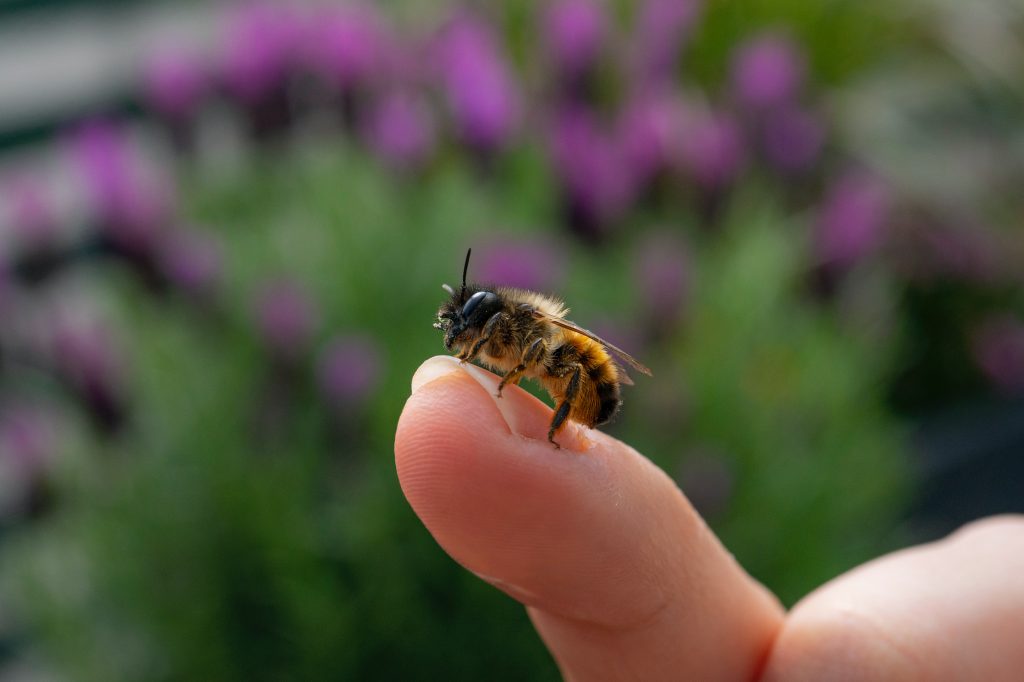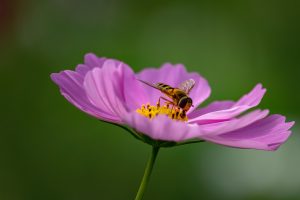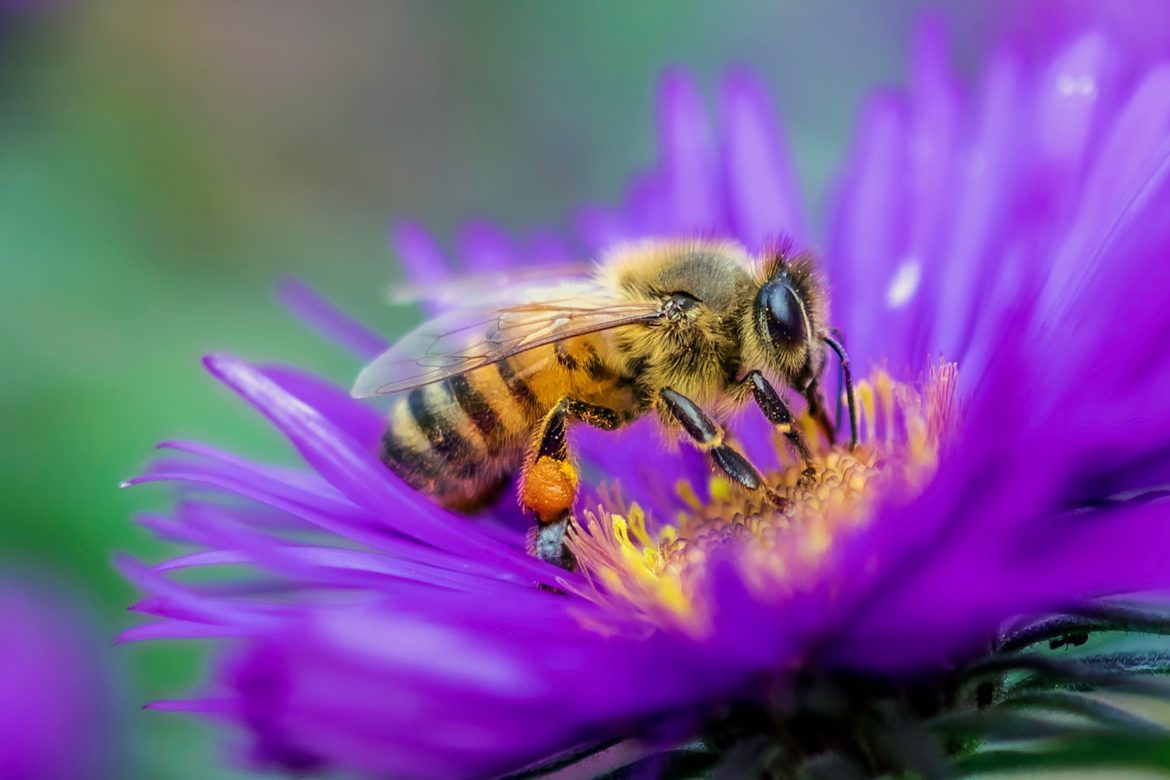by Laurie Klein
I will show them my wonders. —Micah 7:15
Without bees, life would languish. Essentially entwined with humanity’s welfare, honey bees deserve our support for their work in this world. Lately, they top my Wonder Index.
Imagine a car moving through a school zone. A honey bee can match 15-20 mph—for up to six miles. Whereas the human foot lightly depresses the accelerator, four wings rev 200 times per second, 11,400 times per minute.
Thus, the signature buzz.
Bees embody zeal. Like impassioned people, they go the distance. Next time you sweeten your tea, survey your spoon. Two tablespoons of honey would fuel a female’s flight around the earth. Yet her fleeting life’s work produces less than one teaspoon of honey. To produce a pound’s worth, the foraging sisterhood must fly 90,000 air miles, beelining among roughly two million flowers.
In America, the average honey lover consumes nearly 1½ pounds per year. Consider the mileage.

By God’s design, a bee is both a math whiz and a master builder, computing the shortest flit between blossoms as well as designing nature’s most efficient structure: honeycomb walls mitered at precise 120-degree angles. In a house of hexagons, the colony can yearly process 100 pounds of honey, providing nutrients and antioxidants to enhance the health of our skin and brain function. Honey also fosters healing. Not to mention delight.
Years ago, my mother excelled at enticing our busy toddler to alight. “Tea party time!” she’d call. The lure of honeyed raisin toast and gentle conversation before naptime captivated and nourished our daughter’s attention span.
Sweetness entices bees as well. Smear a jar with honey and foragers will detour to drop in. Were they to eyeball the person holding the jar, they’d take in the face, feature by feature, the same way we do—eyes, nose, whiskers, lips—piecing the parts into a complete image. Biologists call this “configural processing.” Experiments show bees can even learn to recognize specific faces. These studies may assist computer scientists working with facial recognition technology.
Bees share other similarities with us. Their vocational roles, like ours, pulse with possibility. Drones romance the queen. Scout bees hardwired for adventure stake out new blooms. Mid-lifers moonlight as undertakers, clearing away the fallen.
Can a bee go bad? Yes. Wily robber bees stalk compromised hives for easy honey. Thank heaven for soldier bees. Think of them as the muscle: mini-bouncers and bodyguards clocking in for security detail.
As followers of Christ, we also serve our communities. We attend to family concerns. Some build; others search out new resources and opportunities. Hopefully, we guard what God entrusts to us. Whatever our calling, we carry the precious nectar of the gospel.
But it’s costly, showing up for each other, day after day. Seeking the good of an entity greater than ourselves, we keep saying yes to our small, often unnoticed, utterly unglamorous assignments. And yet. Every yes contributes to the soundtrack humming beneath our days, a hymn of praise to the King who loves us—no matter how well we perform, no matter how much we love our work.
But roles change. Especially during a global pandemic.
Bees also adapt to the changing needs of the hive, sometimes, with startling results. After young nurse bees finish raising a hatch of larvae, they become upwardly mobile pollen runners. The new work depletes them. Recent experiments show that reassigning these wearied bees to larval care again rejuvenates their brain chemistry, bolstering a protein that reverses aging. It’s the same protein found in our brains, which can help fend off dementia. Further research may help us all thrive longer.
Versatile, industrious, focused—honey bees, in all their roles, enrich our lives in myriad ways.
But here’s the buzzkill, and it’s one of the pressing reasons to channel gratitude into practical action by getting involved on World Bee Day. Or any day. In recent years, pollinator-dependent crops have burgeoned. Colonies, however, are vanishing.
No one knows why.
Identified as “colony collapse disorder,” billions of honey bees across the world are abandoning their hives. In some regions, up to 90% are gone.
In response, the United Nations launched World Bee Day in 2018: “To raise awareness of the importance of pollinators, the threats they face and their contribution to sustainable development.”
Beekeeping takes many forms. To support their wonder-filled work, I’ve shouldered a few new roles: buying local organic produce, growing flowers bees love, and maintaining outdoor water bowls. And this heads my annual holiday wish list: Donate bees to immigrants and refugees.
What might you do?

If you take photos or write nature poems, consider submitting work to Tiny Seed Journal. A portion of your submission fee supports Pollinator Partnership.
OTHER IDEAS:
- Plant nectar-rich lavender, rosemary, and bluebells
- Plant diverse native plants with different flowering times
- Buy raw honey from local farmers
- Choose organic produce whenever you can
- Purge your landscape of pesticides, fungicides, and herbicides
- Sponsor a hive
Sources:
- Feature Photo by Dustin Humes on Unsplash
- Photo with bee on finger by Anni Kat on Unsplash
- Closing Photo by abcd efgh on Unsplash
- Animated video on colony collapse: https://ed.ted.com/lessons/the-case-of-the-vanishing-honeybees-emma-bryce
- “Eat honey, my son, for it is good . . . Know also that wisdom is like honey for you: If you find it, there is a future hope for you, and your hope will not be cut off” (Prov. 24:13-14 NIV).
Join us for Making Time for a Sacred Summer virtual retreat with Christine Sine and Lilly Lewin!


